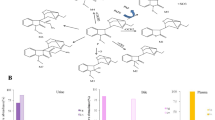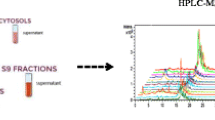Abstract
The metabolism of a promising antineoplastic agent, trans-2,6-difluoro-4′-(N,N-dimethylamino)stilbene (DFS), was studied in mouse, rat, and human liver microsomes using liquid chromatography-tandem mass spectrometry (LC-MS/MS) with the multiple reaction monitoring-information-dependent acquisition-enhanced product ion scan (MRM-IDA-EPI) method. Ten putative metabolites were identified and the structures of four metabolites were confirmed using authentic standards. Since trans-2,6-difluoro-4′-(N-methylamino)stilbene (DMDFS, M1) was present in all species as metabolite and displayed in vitro growth inhibition superior to DFS, its pharmacokinetic profiles were examined in Sprague–Dawley rats using DFS as a comparator. A reliable LC-MS/MS multiple reaction monitoring (MRM) method was subsequently developed and validated for the simultaneous quantification of both DFS and DMDFS in rat plasma for this purpose. Upon intravenous administration (4 mg/kg), DFS had a moderate clearance (Cl = 62.7 ± 23.2 mL/min/kg), terminal elimination half-life (t 1/2 λZ = 299 ± 73 min), and mean transit time (MTT = 123 ± 14 min) with demethylation metabolism accounting for about 10 % of its total clearance. DMDFS possessed an intravenous pharmacokinetic profile similar to DFS. During oral dosing (10 mg/kg) where both DFS and DMDFS were absorbed rapidly, the oral bioavailability of DFS was approximately 2-fold greater than that of DMDFS (DFS: F = 42.1 ± 12.8 %; DMDFS: F = 18.7 ± 3.9 %). Interestingly, the DMDFS exposure after oral dosing of DFS (10 mg/kg) was comparable to that after oral administration of DMDFS (10 mg/kg) alone. As DFS displayed potent anticancer activities and excellent pharmacokinetic profiles, it appears to be a favorable candidate for further pharmaceutical development.






Similar content being viewed by others
References
Baur JA, Sinclair DA (2006) Therapeutic potential of resveratrol: the in vivo evidence. Nat Rev Drug Discov 5(6):493–506
Fulda S (2010) Resveratrol and derivatives for the prevention and treatment of cancer. Drug Discov Today 15(17–18):757–765
Saiko P, Szakmary A, Jaeger W, Szekeres T (2008) Resveratrol and its analogs: defense against cancer, coronary disease and neurodegenerative maladies or just a fad? Mutat Res Rev Mutat Res 658(1–2):68–94
Goldberg DM, Yan J, Soleas GJ (2003) Absorption of three wine-related polyphenols in three different matrices by healthy subjects. Clin Biochem 36(1):79–87
Meng XL, Yang JY, Chen GL, Wang LH, Zhang LJ, Wang S, Li J, Wu CF (2008) Effects of resveratrol and its derivatives on lipopolysaccharide-induced microglial activation and their structure-activity relationships. Chem Biol Interact 174(1):51–59
Kondratyuk TP, Park EJ, Marler LE, Ahn S, Yuan Y, Choi Y, Yu R, van Breemen RB, Sun B, Hoshino J, Cushman M, Jermihov KC, Mesecar AD, Grubbs CJ, Pezzuto JM (2011) Resveratrol derivatives as promising chemopreventive agents with improved potency and selectivity. Mol Nutr Food Res 55(8):1249–1265
Zhang W, Sviripa V, Kril LM, Chen X, Yu T, Shi J, Rychahou P, Evers BM, Watt DS, Liu C (2011) Fluorinated N,N-dialkylaminostilbenes for wnt pathway inhibition and colon cancer repression. J Med Chem 54(5):1288–1297
Lin HS, Sviripa VM, Watt DS, Liu C, Xiang TX, Anderson BD, Ong PS, Ho PC (2013) Quantification of trans-2,6-difluoro-4′-N,N-dimethylaminostilbene in rat plasma: application to a pharmacokinetic study. J Pharm Biomed Anal 72:115–120
Zhang W, Sviripa V, Chen X, Shi J, Yu T, Hamza A, Ward ND, Kril LM, Vander Kooi CW, Zhan CG, Evers BM, Watt DS, Liu C (2013) Fluorinated N,N-dialkylaminostilbenes repress colon cancer by targeting methionine S-adenosyltransferase 2A. ACS Chem Biol 8(4):796–803
Fura A (2006) Role of pharmacologically active metabolites in drug discovery and development. Drug Discov Today 11(3–4):133–142
King R, Fernandez-Metzler C (2006) The use of Qtrap technology in drug metabolism. Curr Drug Metab 7(5):541–545
Yao M, Ma L, Duchoslav E, Zhu M (2009) Rapid screening and characterization of drug metabolites using multiple ion monitoring dependent product ion scan and postacquisition data mining on a hybrid triple quadrupole-linear ion trap mass spectrometer. Rapid Commun Mass Spectrom 23(11):1683–1693
Shou WZ, Magis L, Li AC, Naidong W, Bryant MS (2005) A novel approach to perform metabolite screening during the quantitative LC-MS/MS analyses of in vitro metabolic stability samples using a hybrid triple-quadrupole linear ion trap mass spectrometer. J Mass Spectrom 40(10):1347–1356
Sviripa VM, Zhang W, Balia AG, Tsodikov OV, Nickell JR, Gizard F, Yu T, Lee EY, Dwoskin LP, Liu C, Watt DS (2014) 2′,6′-Dihalostyrylanilines, pyridines, and pyrimidines for the inhibition of the catalytic subunit of methionine s-adenosyltransferase-2. J Med Chem 57(14):6083–6091
Yeo SC, Luo W, Wu J, Ho PC, Lin HS (2013) Quantification of pinosylvin in rat plasma by liquid chromatography-tandem mass spectrometry: application to a pre-clinical pharmacokinetic study. J Chromatogr B 931:68–74
Choo QY, Yeo SC, Ho PC, Tanaka Y, Lin HS (2014) Pterostilbene surpassed resveratrol for anti-inflammatory application: potency consideration and pharmacokinetics perspective. J Funct Foods 11:352–362
Yeo SC, Ho PC, Lin HS (2013) Pharmacokinetics of pterostilbene in Sprague-Dawley rats: the impacts of aqueous solubility, fasting, dose escalation, and dosing route on bioavailability. Mol Nutr Food Res 57(6):1015–1025
Chen W, Yeo SC, Elhennawy MG, Xiang X, Lin HS (2015) Determination of naturally occurring resveratrol analog trans-4,4′-dihydroxystilbene in rat plasma by liquid chromatography-tandem mass spectrometry: application to a pharmacokinetic study. Anal Bioanal Chem. doi:10.1007/s00216-015-8762-7
Azorin-Ortuno M, Yanez-Gascon MJ, Vallejo F, Pallares FJ, Larrosa M, Lucas R, Morales JC, Tomas-Barberan FA, Garcia-Conesa MT, Espin JC (2011) Metabolites and tissue distribution of resveratrol in the pig. Mol Nutr Food Res 55(8):1154–1168
Gusten H, Klasinc L, Kramer V, Marsel J (1974) Mass-spectra of monosubstituted trans-stilbenes. Org Mass Spectrom 8:323–334
Xia Y-Q, Miller JD, Bakhtiar R, Franklin RB, Liu DQ (2003) Use of a quadrupole linear ion trap mass spectrometer in metabolite identification and bioanalysis. Rapid Commun Mass Spectrom 17(11):1137–1145
Li AC, Alton D, Bryant MS, Shou WZ (2005) Simultaneously quantifying parent drugs and screening for metabolites in plasma pharmacokinetic samples using selected reaction monitoring information-dependent acquisition on a QTrap instrument. Rapid Commun Mass Spectrom 19(14):1943–1950
Huang J, Si L, Fan Z, Hu L, Qiu J, Li G (2011) In vitro metabolic stability and metabolite profiling of TJ0711 hydrochloride, a newly developed vasodilatory beta-blocker, using a liquid chromatography-tandem mass spectrometry method. J Chromatogr B 879(30):3386–3392
Martignoni M, Groothuis GM, de Kanter R (2006) Species differences between mouse, rat, dog, monkey and human CYP-mediated drug metabolism, inhibition and induction. Expert Opin Drug Metab Toxicol 2(6):875–894
Obach RS (2013) Pharmacologically active drug metabolites: impact on drug discovery and pharmacotherapy. Pharmacol Rev 65(2):578–640
Hurst S, Loi CM, Brodfuehrer J, El-Kattan A (2007) Impact of physiological, physicochemical and biopharmaceutical factors in absorption and metabolism mechanisms on the drug oral bioavailability of rats and humans. Expert Opin Drug Metab Toxicol 3(4):469–489
Lin HS, Spatafora C, Tringali C, Ho PC (2012) Determination of trans-2,4,3′,4′,5′-pentamethoxystilbene in rat plasma and its application to a pharmacokinetic study. J Pharm Biomed Anal 57:94–98
Lin HS, Ho PC (2011) Preclinical pharmacokinetic evaluation of resveratrol trimethyl ether in Sprague-Dawley rats: the impacts of aqueous solubility, dose escalation, food and repeated dosing on oral bioavailability. J Pharm Sci 100(10):4491–4500
Braddy AC, Jackson AJ (2010) Role of metabolites for drugs that undergo nonlinear first-pass effect: impact on bioequivalency assessment using single-dose simulations. J Pharm Sci 99(1):515–523
Acknowledgments
HSL was supported by a start-up grant from the National University of Singapore (R-148-000-174-133). SCMY is a recipient of the President’s Graduate Fellowship of the National University of Singapore. CL and DSW were supported by R21 CA139359 and CA172379 from the NIH. DSW was supported by the Office of the Dean of the College of Medicine and by NIH Grant Number P20 RR020171 from the National Institute of General Medical Sciences to L. Hersh, PI. Its contents are solely the responsibility of the authors and do not necessarily represent the official views of the NIH or the NIGMS.
Conflict of interest
Samuel Chao Ming Yeo, Meng Huang, and Hai-Shu Lin declare that they have no conflict of interest. Vitaliy M. Sviripa, David S. Watt, and Chunming Liu declare that they are the inventors of “Stilbene analogs and methods of treating cancer” (US Patent 20120196874).
Author information
Authors and Affiliations
Corresponding author
Electronic supplementary material
Below is the link to the electronic supplementary material.
ESM 1
(PDF 35.5 kb)
Rights and permissions
About this article
Cite this article
Yeo, S.C.M., Sviripa, V.M., Huang, M. et al. Analysis of trans-2,6-difluoro-4′-(N,N-dimethylamino)stilbene (DFS) in biological samples by liquid chromatography-tandem mass spectrometry: metabolite identification and pharmacokinetics. Anal Bioanal Chem 407, 7319–7332 (2015). https://doi.org/10.1007/s00216-015-8893-x
Received:
Revised:
Accepted:
Published:
Issue Date:
DOI: https://doi.org/10.1007/s00216-015-8893-x




